Portraits of Pain: Clinical Photography of Children as a Social Marker[1]
Abstract
In 1986, Museum Boerhaave, the National Museum for the History of Science and Medicine in the Netherlands, acquired a collection of three thousand glass negatives from a tuberculosis sanatorium in Katwijk aan Zee. This paper investigates aspects of social awareness in medical photography, taking this collection as a case study. These clinical images reveal a hidden world of suffering and social awareness, whilst simultaneously acting as a typical archive of medical portraits and typologies. A far cry from the happy children on popular postcards depicting sanatoria, the photographs attest to children suffering from disease, but they never lose their force as portraits. Produced as objective documents of disease, the direct portraits reveal the social awareness of poverty, as well as the hardships, pain and pride of the young patients in an important era of Dutch photography and social medicine.
Article
Introduction
Bumps, spots, sores, and curved spines – the children at the Zeehospitium were painfully aware of them. The young children staying in this Dutch sanatorium in Katwijk were being treated for tuberculosis, but they were also there to recover from the poorest living conditions in nearby cities such as Rotterdam and The Hague. The lives of these patients have been immortalized in a collection of black and white glass negatives, now preserved at the Museum Boerhaave. The collection contains approximately three thousand items, which were most likely taken by one person, the head-physician, at the Zeehospitium during the years 1908 to 1940. The physician photographed most of the children on the metal treatment table or in front of a black cloth. As such, the collection is a prime example of amateur photographs taken by physicians in the early twentieth century. However, the collection is not merely a silent witness of illness and treatment, nor of healing and pain. The photographs also echo the social context of Dutch medicine and society in the early decades of the twentieth century.
This paper investigates aspects of ‘social awareness’ that arose in Dutch medical photography, taking the Zeehospitium collection as its chief example. This type of photographic work did not simply involve the consequences of negative power in medical and other surveillance photography, as is often discussed in historical literature. Photographic portraiture, as discussed by the historians John Tagg, Peter Hamilton, Ludmilla Jordanova and others, became a medium that was used to inscribe individuals, their status and social identity, e.g. the insane, criminals or racial types.[2] I argue that the photographs of Dutch tubercular children go beyond these aspects of surveillance, and as well represent suffering, hope and strength. Whilst medical photographs in the past undoubtedly served within the context of state control reinforcing social division[3], these early clinical portraits at the same time expressed a social viewpoint of the diseased. In this sense, these collections are in line with the desire to register and reveal social injustice as seen in early social documentary photography, representing poor living conditions in slums, poverty, or child labor.
Physicians of different scientific fields and branches of medicine had started using photography fairly soon after the invention of the daguerreotype in 1839.[4] From the 1860s on, photographs became a popular means of documenting patients. Physicians regarded the photograph as a suitable didactic medium because it could be used to register and recall the clinical presentation of diseases in patients. Furthermore, new theoretical insights into the role of medical photography in institutional settings of the nineteenth and early twentieth century have been provided by historians in the field of cultural studies and art history.[5] They have addressed the social uses of photographs in the case of psychiatry, for example, stressing the archival reinforcement of the mentally ill as deviant typologies. Following more recent work on ‘the photographic archive, I would like to highlight the dual role of collecting photographs of tubercular children, stressing both their archival function as well as their presence as everyday images of social concern and care.[6]
Tuberculosis has been historically regarded as a ‘social’ disease, flourishing in poverty.[7] In the humanities, the history of tuberculosis has generated a great deal of attention over the years, with ample research into the changing scientific and cultural conceptions of the disease.[8] Historians, however, have hardly discussed the photographing of cases of tuberculosis as a separate subject.[9] Regarding the often ‘invisible’ clinical aspects of the disease, historians have instead focused on visual sources concerning, for instance, the role of architecture as a curative environment for tuberculosis patients.[10] This article aims to initiate an exploration of social awareness in the photography of this infectious disease with respect to a group of victims that has almost been forgotten.
Images and the sanatorium
Rows of glass, neatly stacked together in brown cardboard boxes: this is how the collection of glass negatives arrived at the Museum Boerhaave, the National Museum for the History of Science and Medicine in the Netherlands, in 1986.[11] The museum had acquired the collection of 255 boxes, containing approximately three thousand glass negatives, from the former sanatorium ‘Zeehospitium’ in Katwijk aan Zee (South Holland). Anno 2014, 811 negatives with the dimensions 90 x 120 mm have been digitized and online disclosed.[12]
The images show clinical portraits of children with tuberculosis in various positions.[13] Taking the negatives from 1922, for example[14], we can observe children standing on a wooden chair, sitting on a stool, or placed on a treatment table, with their bodies semi-undressed. (Fig. 1) Occasionally, a nurse is seen holding a child in an upright position. (Fig. 2) The setting is probably always the treatment room in the Zeehospitium. A window, a medicine cabinet filled with glass bottles and a balance standing on top of it, a door, or several opened instrument cases: all betray a location used for treatment – not a sleeping hall. Because a black cloth is used as a backdrop in many of the images, it is not possible to determine the precise location where the photographs were taken inside the sanatorium.
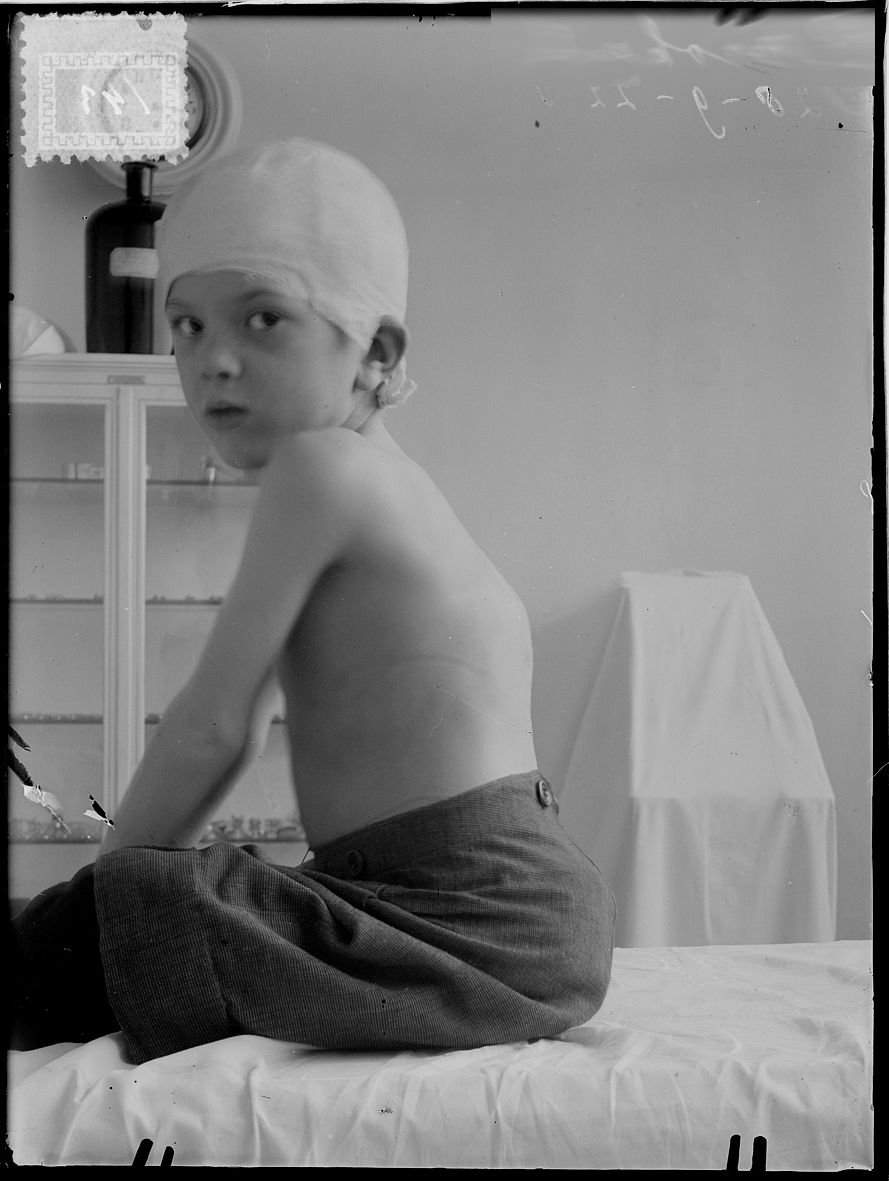 |
Fig. 1. Unknown maker, 1922. Gelatin glass negative, 120 x 90 mm. Leiden, Museum Boerhaave, inv. no. P11333.[66] |
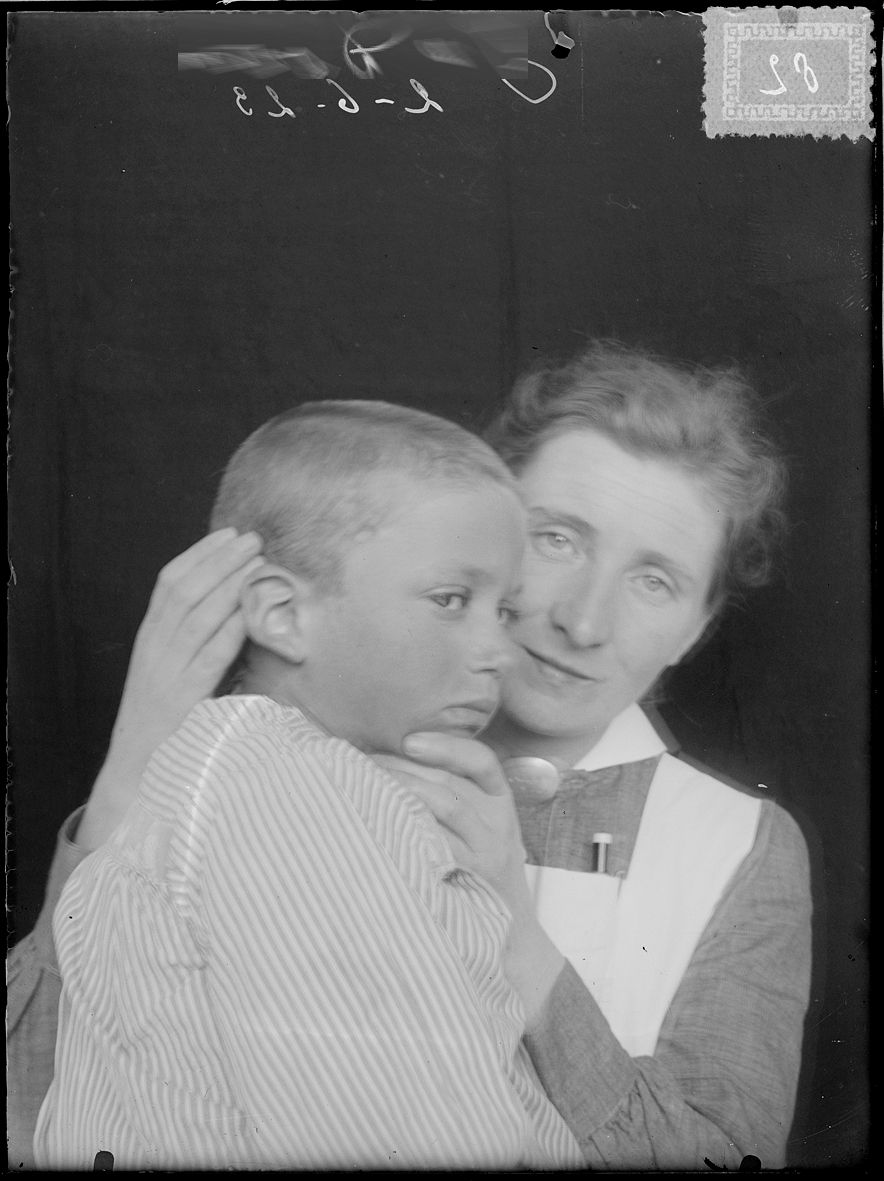 |
Fig. 2. Unknown maker, 1923. Gelatin glass negative, 120 x 90 mm. Leiden, Museum Boerhaave, inv. no. P11391.[66] |
The Rotterdam Zeehospitium was located in the dunes, separated from the small Dutch fishermen’s village of Katwijk aan Zee.[15] The sanatorium opened its doors in 1908 as one of the new sanatoria in the Netherlands, as part of a grand national movement to fight against tuberculosis.[16] Accordingly, the Rotterdam Society to Combat Tuberculosis (Vereeniging tot bestrijding der Tuberculose te Rotterdam) initiated the founding of the Zeehospitium. Many of the young patients in the sanatorium lived in Rotterdam, often in the poorest neighborhoods. The goal of the Zeehospitium was to fortify weak children from all layers of society against the risk of tuberculosis. As mentioned in its 1922 annual report, the society’s goals were to “improve the health, the working ethos, and happiness of our people’s children”, by placing tubercular children in this controlled environment at an early stage, so that they were able to regain their strength in order to beat the tuberculosis infection.[17] Over the years, the Zeehospitium evolved into a renowned sanatorium for tubercular children in the Netherlands.[18]
Tuberculosis was a pervasive disease. In the early twentieth century, the illness was regarded as one of the major deadly diseases, claiming the lives of 1 in every 1000 inhabitants in the Netherlands.[19] The contagious disease is caused by a bacterium transmitted by inhalation through talking, coughing or sneezing. Once contracted, the bacteria can infect any part of the body. While most cases in adults involved pulmonary tuberculosis, children were more prone to tuberculosis of the bones and joints.[20] Although Robert Koch identified the tubercle bacillus in 1882, the methods of treatment remained the same as before his discovery. They consisted of hygienic restrictions, isolation from crowds, resting, good nutritional regiments, and lots of fresh air and sunlight.[21] For tubercular children with affected bones and joints, physicians prescribed similar measures with additional corsets or plaster beds to fix and heal the bones. Until the mid-twentieth century, tuberculosis remained a chronic and largely incurable disease causing severe pain and discomfort.[22]
The emergence of sanatoria like the Zeehospitium was in accordance with the well-known hygienist movement.[23] From the mid-nineteenth century on, the hygienists argued for improvements in hygiene and the supplying of the same level of health care for all, including those living in the poorer neighborhoods.[24] The erection of public sanatoria to treat patients while in the disease’s early stages was seen as a key step in prevention. As an indicator of the forms of inequality, tuberculosis sanatoria became places of physical as well as social recuperation and stigmatization. The price for treatment in the Zeehospitium was considerable per child, but external funding assured that even the poorest of patients could be admitted for care.[25] Charity, in general, played a substantial role in the development of sanatoria such as the Zeehospitium. In the case of the Zeehospitium, a special book was published for fundraising to finance its founding in 1908.[26] The introduction of this book “for the tubercular children” expressed the wish that “compassion from the big, strong people” be shown the boys and girls.[27] Signatures in the book attested to the commitment of the rich and famous, including Queen Wilhelmina, as well as the medical and cultural elite. The Zeehospitium thus served as a prime example of the renewed social hygienic interest in children who were prone to falling ill with tuberculosis.
A medical portrait
The photographs of children at the Zeehospitium were produced and intended as medical documents. They vividly registered the visual symptoms and developments of a painful disease and its treatments. All photographs recorded some stage or type of tuberculosis, be it an ulceration, dysmorphic legs, or a corrected corset tightly containing a naked body. To ensure a focus on the affected part of the body, the physician or nurse often marked the area to be observed by drawing a circle around the spot on the skin itself. Similarly, early medical photographs of skin diseases were dabbed in by hand with color in those areas of the skin that were affected.[28]
The identity of the maker of the photographs in the Zeehospitium collection is unknown. The most likely candidate is the female medical director of the Zeehospitium, Dieuwke Baukje van Dorp-Beucker Andreae (1880-1960). Upon completing her medical studies in Utrecht, she married the chemist Gerard C.A. van Dorp and started immediately as the medical director in the Rotterdam Zeehospitium. She led the sanatorium from its opening in 1908 until her retirement in 1942 – a period that matches the time span of the glass negatives precisely. During the period of her impassioned leadership, she published various articles on tuberculosis and other related medical subjects in the Dutch medical journal Nederlands Tijdschrift voor Geneeskunde.[29] Furthermore, we know that she owned a lantern for the projection of glass slides and that she knew how to operate it.[30] Considering that she came from a family that was well to do, she is certain to have had ample experience with photography, both through her father, who was interested in photography, as well as being the subject of photographic portraits herself.[31]
In Van Dorp-Beucker Andreae’s medical publications, the photographs functioned as medical evidence. She used images identical to the clinical images found in the glass negative collection.[32] When compared to the original glass negative, the images included in the article were notably cropped. In one particular article, the photographs demonstrated the beneficial effects of sun on tuberculosis. All images have a ‘before and after’ sequence, visualizing the progress made by the children over time. In one case, the photographs figure as part of a young boy’s disease history, ‘very fragile’ with ‘several tubercle processes’.[33] After several months of solar treatment, the sores under his face and on his hands had improved remarkably, according to Van Dorp-Beucker Andreae. Referring to the images, she concluded that the boy was changed from a fragile child into a sturdy, healthy boy who had gained eight kilos in weight. The images attest to this positive turn. Throughout the digitized portion of the Zeehospitium collection, there are numerous examples of tubercular children followed in the process of their illness and recovery. (Fig. 3)
 |
Fig. 3. Unknown maker, 1923. Gelatin glass negative, 120 x 90 mm. Leiden, Museum Boerhaave, inv. no. P11652.[66] |
Using photographs to record or follow disease processes was not new. From the very start, photography was used to capture scientific and medical phenomena (in time). In the 1840s, physicians, microscopists and astronomers began experimenting with photographic processes for their illustrations.[34] In the United States, physicians were already using the daguerreotype for the recording of medical subjects by as early as the late 1840s.[35] An important early example of photographing patients is the well-known and documented work carried out by the British physician Hugh Welch Diamond (1809-1886).[36] His photographs mark the start of photographing insane patients.[37] For Diamond, the potential of photography for analysis, classification and communication was unparalleled. In his view, the photographs could be of great use for both diagnosis and treatment. Indeed, Diamond was one of the first physicians to propagate and integrate photographic techniques in medical practice itself. His photographic portraits of the insane were tools to order, classify and archive faces of the degenerate. At the same time, the photographs had a function in the healing process.[38] For Van Dorp-Beucker Andreae in the early twentieth century, photographing her young patients served a number of similar purposes: to register the medical situation, to monitor disease processes, and to order and classify patients according to their symptoms. In the sanatorium’s annual reports, she always made a clear classification of the types of tuberculosis.[39] The results of the treatments were accordingly organized and annotated.
The external manifestation of tuberculosis, such as sores and bone deformations, are clearly evident in the Zeehospitium collection. Skin affections were the main subject in the early photography of patients.[40] After 1850, photographs of patients were published in works related to emerging fields in medical specialization such as military medicine, psychiatry, orthopedics, physiognomy and dermatology.[41] The literary scholar Erin O’Conner reasoned that photography was particularly suited to documenting patients in these particular fields because of their inherent relationship to the surface of the human body.[42] In photographs of tubercular children, the cases involving surgical tuberculosis were most rewarding to document, as opposed to children with a pulmonary infection alone.[43]
Besides functioning as documents of observation and classification, the glass negatives were also ‘portraits of disease’. Portraiture greatly influenced medical photography. This was related, among other things, to the importance of the face in fields such as physiognomy, psychiatry and anthropology. By the mid-nineteenth century, photographic processes were functioning as ways to “record and transmit socially important information about individuals”, and as such, they played a crucial part in the “emergent ideas about individuality, personality and character”, as historian Peter Hamilton has shown.[44] The photographic portrait had become a medium that inscribed both the individual and his social identity.[45] Around 1900, the application of bertillonage, an early means of photographic identification set up by the Parisian policeman Alphonse Bertillon, was widely dispersed among institutions involving surveillance, e.g. the police and prisons, as well as among anthropologists.[46] This included the physiognomic conventions of full-face and profile photographs to document a person’s identity.
The concept of drawing quantitative information from a photograph as evidence is also relevant to the Zeehospitium collection. A series of photographs for a single patient often entailed a frontal image and a profile recording, sometimes supplemented with additional shots of the affected area taken from different angles. (Figs. 4 and 5) According to the bertillonage, the photographs are therefore true portraits of disease, making it possible to register the identity of tuberculosis. To ensure the sores were visible in the photograph with a maximum of clarity, the nurses turned the child’s body or head in the appropriate position. As a whole, the collection exemplifies a portrait of tuberculosis in children, varying from the most painful ulcerated sores to spinal curvature. Did tuberculosis define these children? As Peter Hamilton argued, portrait photography emphasized the existence of “classes, categories and types of people (…) as a servant to systems of classification designed to control and restrict, but also, paradoxically, to cure and heal.”[47] The photographic collection of the Zeehospitium sanatorium defines a group of children by their disease, portraying them as sickly bodies.
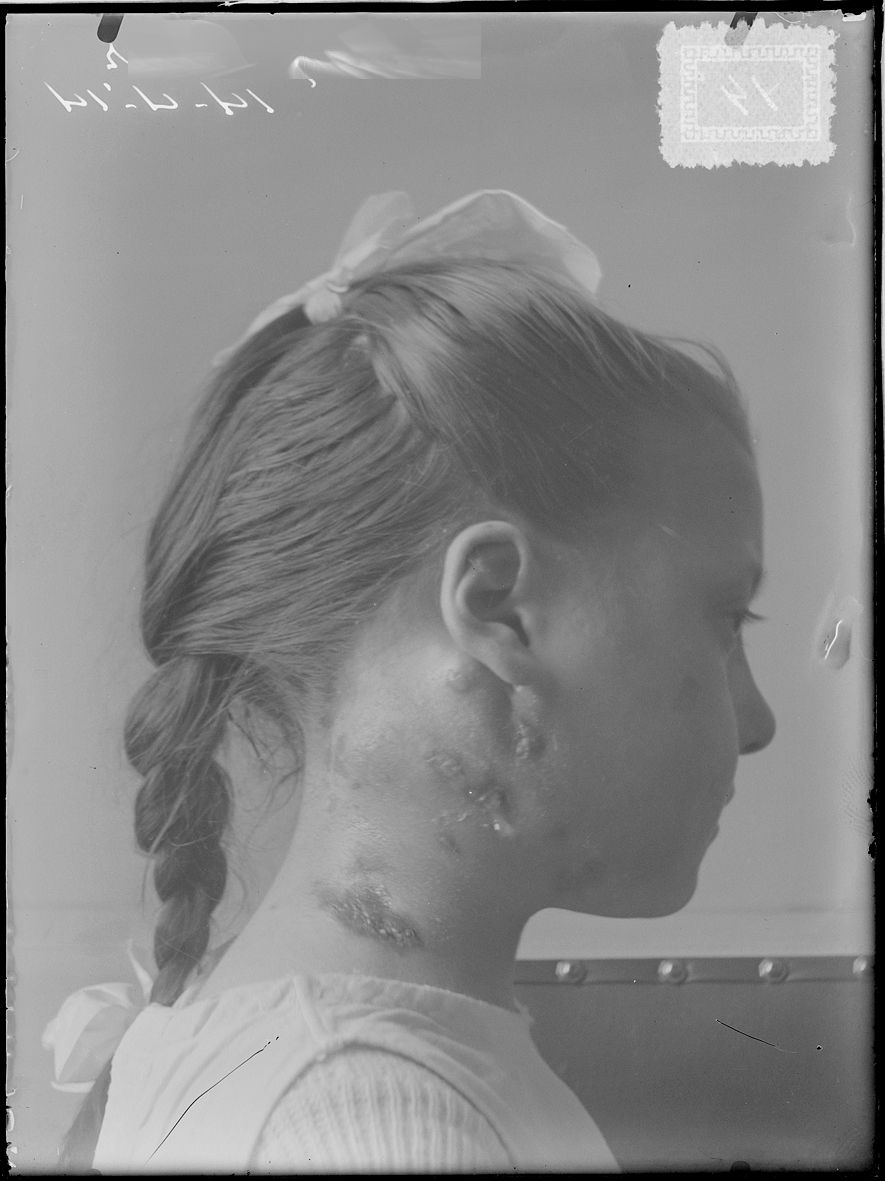 |
Fig. 4. Unknown maker, 1914. Gelatin glass negative, 120 x 90 mm. Leiden, Museum Boerhaave, inv. no. P11359.[66] |
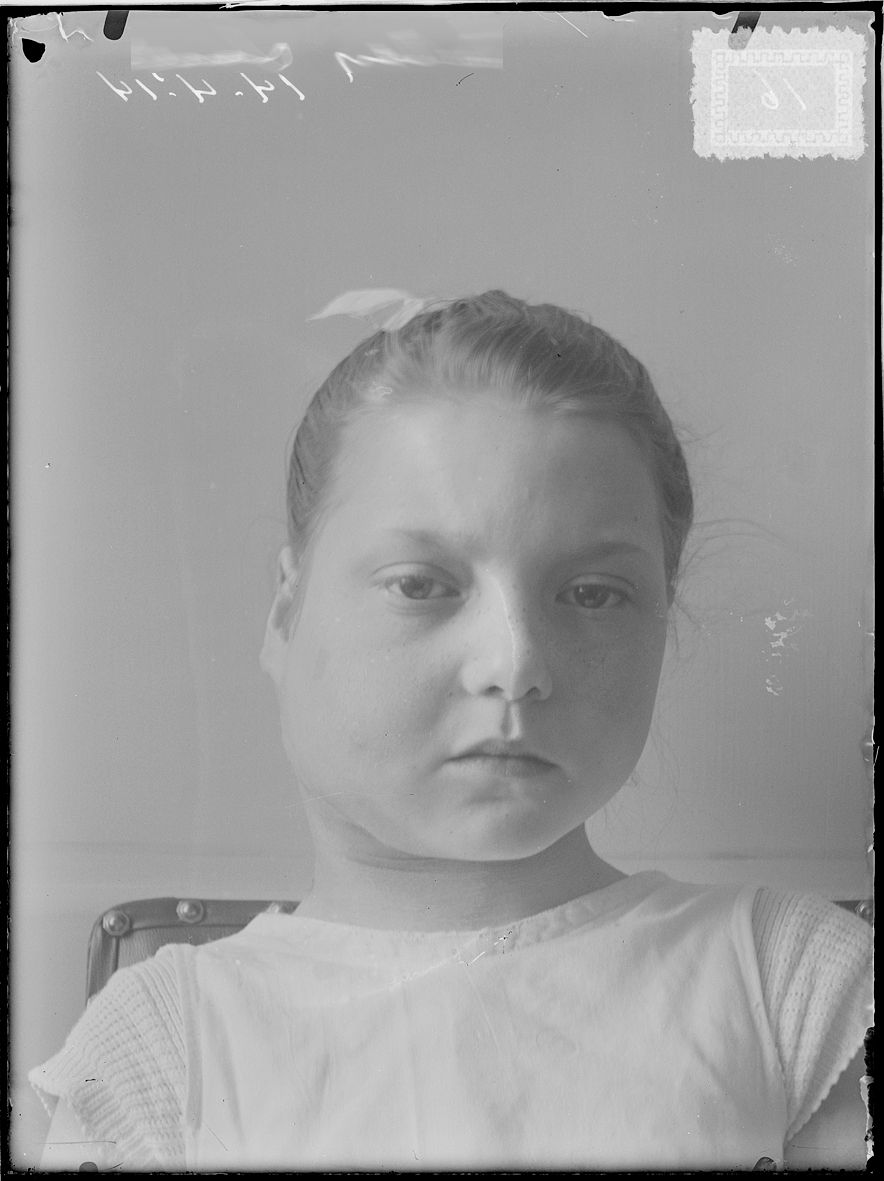 |
Fig. 5. Unknown maker, 1914. Gelatin glass negative, 120 x 90 mm. Leiden, Museum Boerhaave, inv. no. P11361.[66] |
Standards
To exclude associations with studio portraiture, medical photographers introduced a number of standard conventions. In 1893, the French photographer and scientist Albert Londe (1858-1917) published one of the earliest handbooks on medical photography: La photographie médicale.[48] Londe was the successor to the famous French neurologist Jean-Martin Charcot at the photographic service of the French Salpêtrière hospital in Paris. In La photographie médicale, Londe aimed to help physicians who wanted to set up their own photographic service.[49] He tackled subjects such as the photographing of living and deceased patients, the positioning of the patient, the use of a backdrop in the clinical photograph, and photography of criminals for legal purposes. Most of his work concerned standard ways of photographing the mentally ill, but within decades, his descriptions of the patient’s surroundings had become a standard for clinical photography. Londe explained how the backdrop in a photograph should consist of grey or blue curtains, a background that we would now call ‘neutral’.[50] These colors, together with the nude body of the patient, would have the most ‘harmonious’ effects for the photographs, without producing strong differences between light areas and shadows.[51] Although the patient’s pose was to be as ‘natural’ as possible, Londe’s descriptions were filled with instructions for standardizing the medical photograph. He included, for example, a table of light intensity for the different days and months of the year in Paris, so as to adapt one’s strategy for lighting.[52]
Standardization was also important for the photographer of tubercular children. As an amateur photographer, Dieuwke van Dorp-Beucker Andreae —assuming that she was the photographer— had to deal with the possibilities and limitations provided by the sanatorium. When feasible, she used a white backdrop or a black curtain, either as an even surfaced background or for contrast. Accordingly, a black cloth draped behind a body creates a more dramatic photographic setting. (Fig. 6) Posing, as mentioned earlier, was at times a problem for the younger children. When necessary, nurses held the children. In many cases, however, the moved bodies show how difficult it was to maintain a standard pattern of positions. In most cases, the angle of the photographer is at waist-level, with the child seated on a mobile bed, chair or stool. Many photographs are wide-angle shots, conveying an overall image of the diseased child. Occasionally, the photographer produced close-ups of details, such as the infected forefinger of a small girl. (Fig. 7) Because the set-up of the images remains more or less the same over time, the photographer is likely to have used a camera on a fixed stand. A chronological overview of the images that have been digitized moreover reveals a rather constant style, with close-ups mixed with full-body shots.
 |
Fig. 6. Unknown maker, 1922. Gelatin glass negative, 120 x 90 mm. Leiden, Museum Boerhaave, inv. no. P11219.[66] |
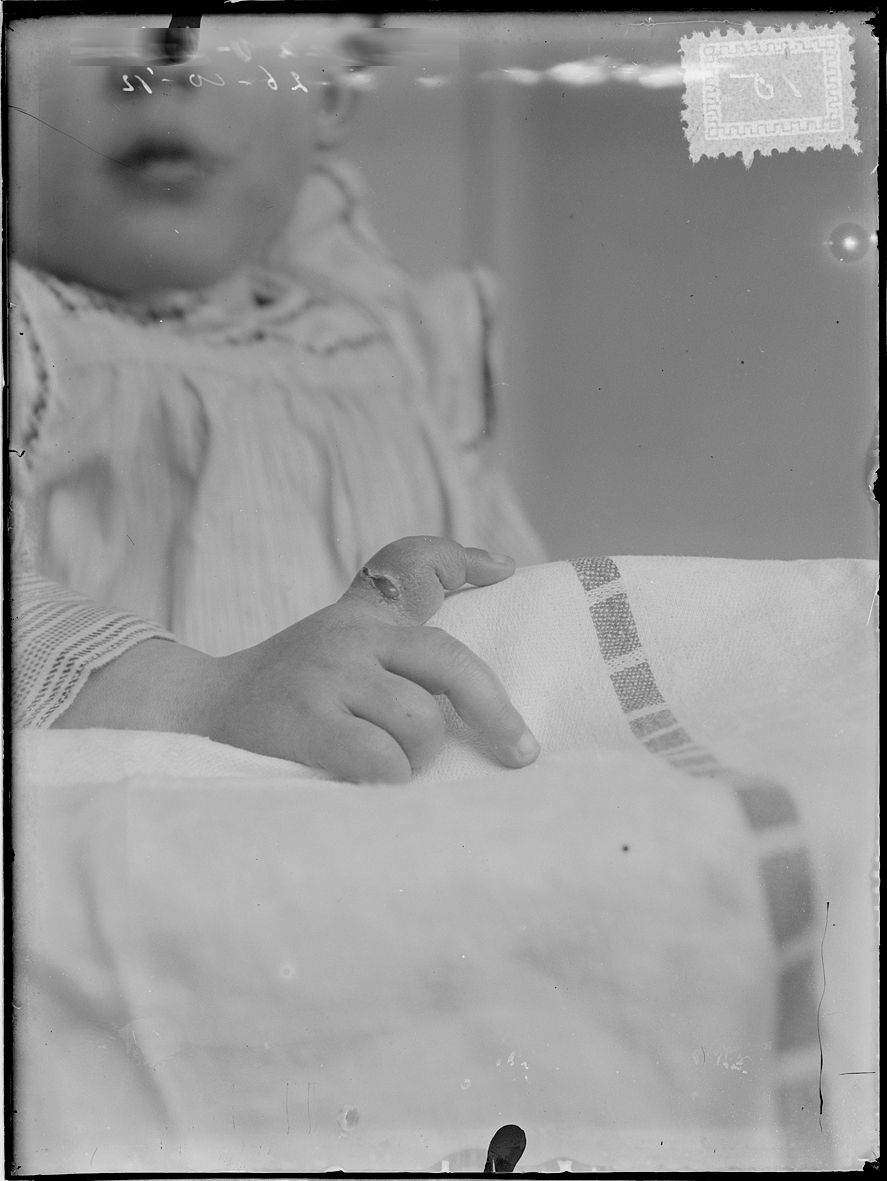 |
Fig. 7. Unknown maker, 1912. Gelatin glass negative, 120 x 90 mm. Leiden, Museum Boerhaave, inv. no. P11288.[66] |
Compassionate observation of fragile lives
Besides the medically driven purpose of the glass negatives, the social context of production is crucial. While the medical director (most likely) photographed the children for medical purposes, with all its implications for classification and restriction, today we may also view these images as indications of a social interest, care and concern for the poor. They are part of a societal understanding of disease, connected to a drive for social change. In the case of the Zeehospitium, the director Dieuwke van Dorp-Beucker Andreae personified the social movement against tuberculosis. Her amateur photographs of tubercular children are part and parcel of the social awareness with which she viewed these patients.
Van Dorp-Beucker Andreae expressed her wish to improve the social circumstances of the tuberculosis patients in several ways. She was active in the Physicians’ Abstainers Society (Artsen Geheelonthouders Vereeniging) and published articles on the topics of alcohol and tuberculosis.[53] At the time, physicians and others believed that alcohol had a negative influence on tuberculosis, chiefly by implying that poor living conditions and alcohol abuse were predispositions to the disease.[54] According to Van Dorp-Beucker Andreae, the use of alcohol damaged the child, directly or indirectly.[55] She considered alcohol an evil that increased one’s chances of getting tuberculosis through physical neglect and poor nutrition. Judging from the Zeehospitium’s policy over the years, medical intervention went hand in hand with social measures to improve health. Keeping up with hygienic propaganda materials of the time, all effort was aimed at removing young children from areas of contagion and poor living conditions and subsequently providing them with good nutrition, movement, fresh air and sunlight.[56] As historian Nelleke Bakker has argued, the anti-tuberculosis campaign between 1910 and 1940 was marked by a child-saving ethos that focused on the poor.[57] Van Dorp-Beucker Andreae and her social activities fit with this scheme.
Another aspect of this socially progressive agenda is evident in the naming of a female director to run the Zeehospitium. At the time, Van Dorp-Beucker Andreae was the first female physician in the Netherlands to run her own pharmacy.[58] Furthermore, the president of the International Council of Women, Lady Aberdeen, visited the sanatorium in 1913.[59] Clearly, the sanatorium was a place where emancipated women wanted to contribute to society by improving the lives of impoverished children.
It is therefore no surprise that, in spite of all efforts to standardize these images as medical portraits, for us these portraits go far beyond the medical realm. For Van Dorp-Beucker Andreae, these photographs of tubercular children figured in a medical context, as I have argued above. As historical documents, however, the glass negatives form delicate moments in the lives of a group that remained virtually unseen to the general populace of their day.
These images of the social and medical reality of tubercular children can be framed within the broader interest and onset of social photography. Van Dorp-Beucker Andreae’s amateur-style photographs are in line with a social awareness of the lives of these ‘poor bastards’, as registered in the documentary photographs of Eugène Atget’s Paris pedlars, Lewis Hine’s working children, or Jacob Riis’ immigrants, in their quest for social change.[60] The facial expressions of children in factories and slums are comparable to expressions of impotence and displacement in tubercular children. (Figs. 8 and 9)
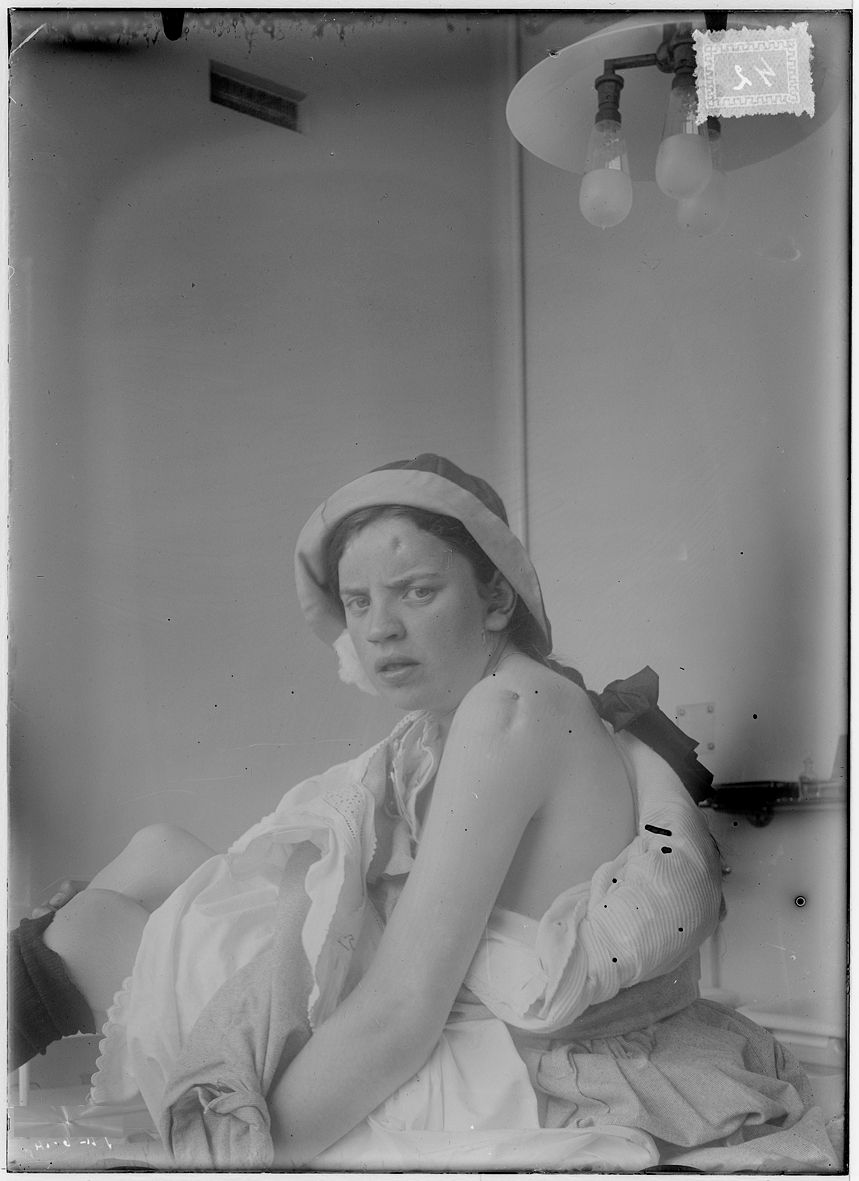 |
Fig. 8. Unknown maker, 1914. Gelatin glass negative, 180 x 130 mm. Leiden, Museum Boerhaave, inv. no. P11446.[66] |
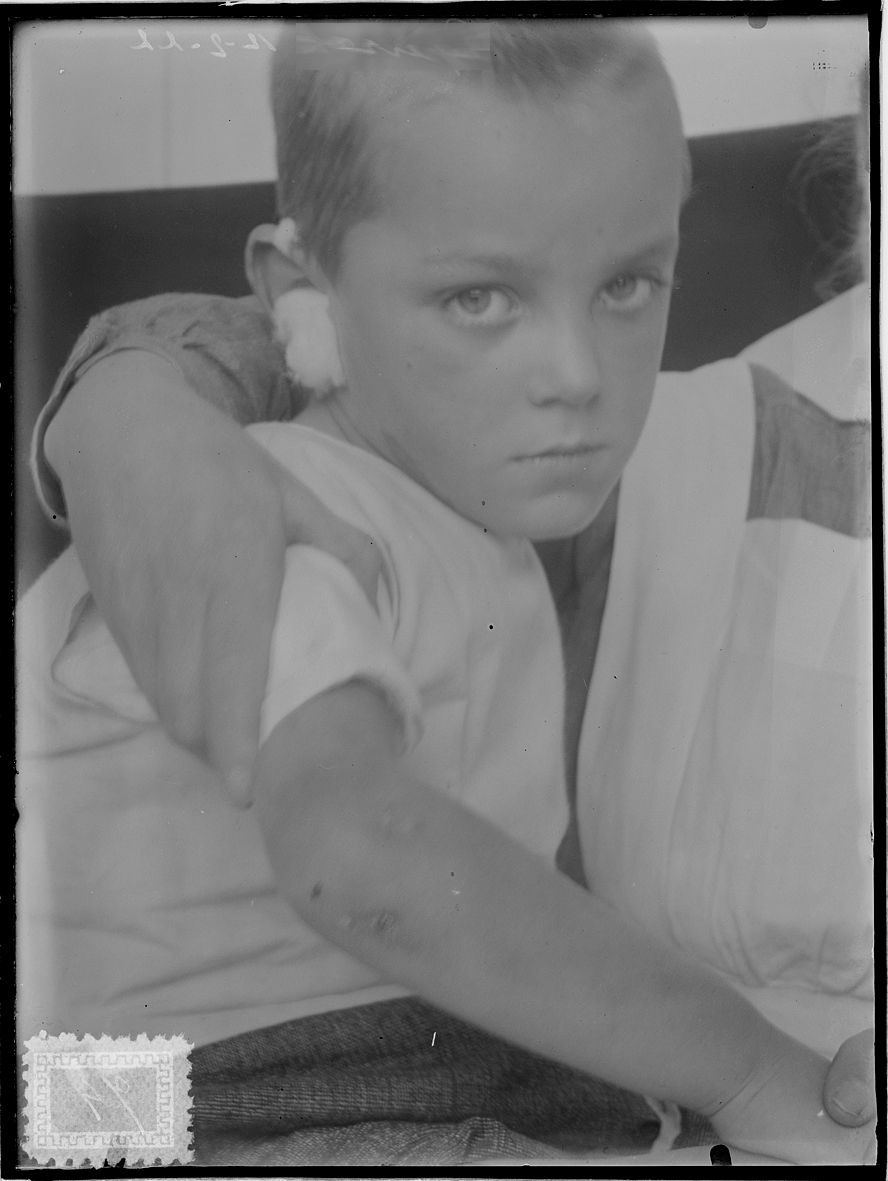 |
Fig. 9. Unknown maker, 1922. Gelatin glass negative, 120 x 90 mm. Leiden, Museum Boerhaave, inv. no. P11027.[66] |
However, two important differences should be mentioned when comparing the Zeehospitium photographs and examples of early social documentary photography. Firstly, these ‘medical’ photographs of tubercular children were not produced for a broad audience, but for a specific medical purpose and public. Although a number of these photographs did appear in the Dutch medical journal Nederlands Tijdschrift voor Geneeskunde, the author did not publish them with the specific intention of bringing about social change. Secondly, it was not the children’s environment or social situation that was recorded in these images, but rather the physical manifestation of poverty and weakness caused by tuberculosis – the ‘social’ disease. The photographs of tubercular children document the process of recovery, from poverty to renewed strength and vigor. As such, the Zeehospitium collection therefore primarily signifies the visualization of the physical and medical sides of social deprivation.
While in slum photography poor living conditions were spelled out in darkness and filth, contrasts between areas of light and dark stand out in the Zeehospitium glass negatives. The sanatorium’s predominantly white surroundings and the black cloth symbolize the journey of the children who were removed from this darkness and moved into the sunlight to heal. In visual terms, darkness was equivalent to poverty and a susceptibility to disease. Tuberculosis was related to poverty, as was clearly demonstrated by the artworks reproduced in The Golden Book for the Tubercular Children (Het gulden boek voor de tuberculeuze kinderen) or in the work of the Dutch artist Louis Raemaekers.[61] (Fig. 10) In the Zeehospitium annual report of 1912, Van Dorp-Beucker Andreae evoked similar contrasts between light and darkness for those children in the Zeehospitium who were obliged to return to their urban environment.[62] The collection of glass negatives generally visualizes the social goal behind the sanatorium in 1908: “For these small citizens (…) who, because they cannot eat to strengthen themselves and do not have a vigorous color in their cheeks, frolicking and sleeping in the stuffy neighborhood air, are even now still defenseless against the evil enemy feared especially by the poor: Tuberculosis.”[63]
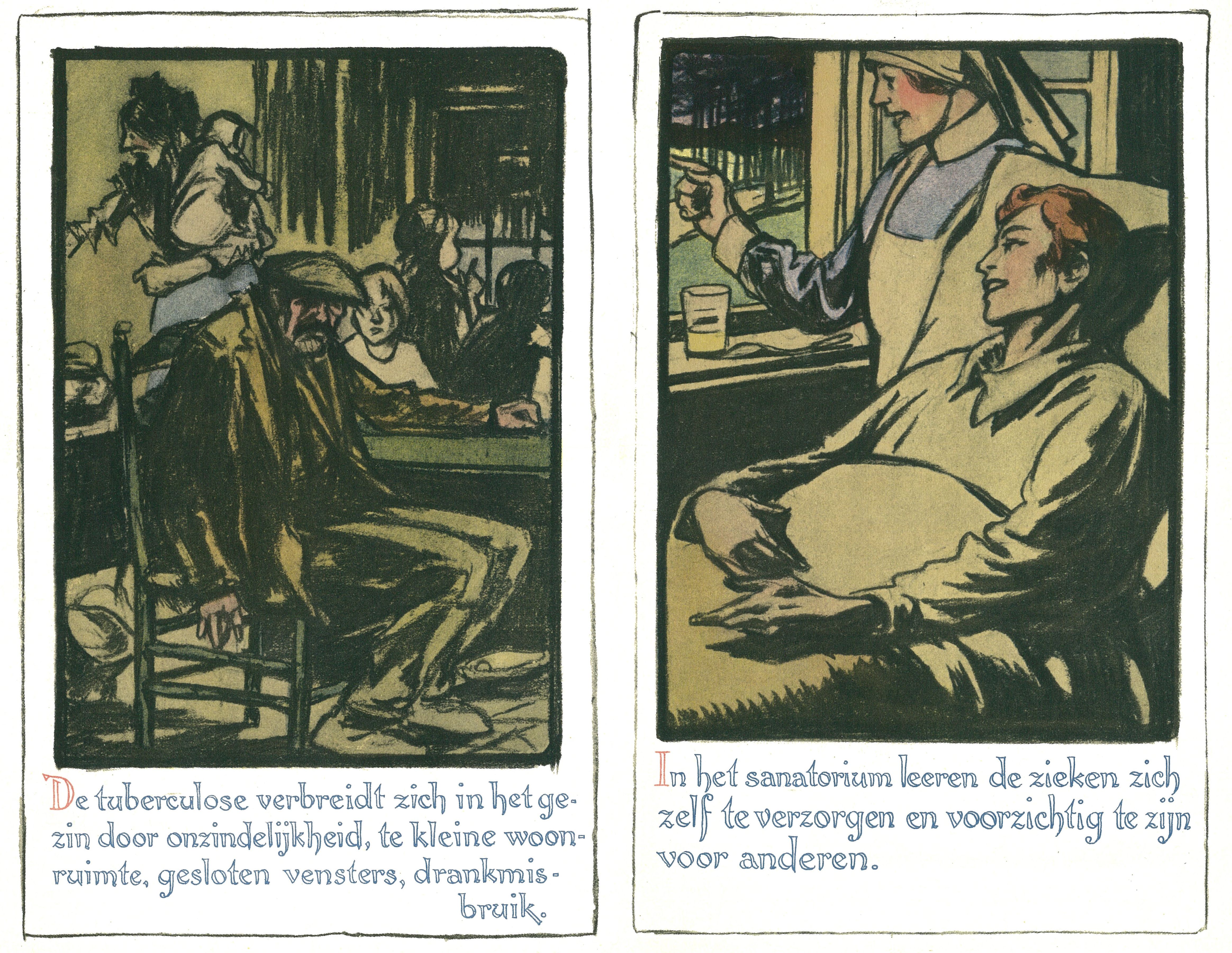 |
Fig. 10. Drawings by Louis Raemaekers published in: Nederlandsche Centrale Vereeniging tot Bestrijding der Tuberculose 1927, Gezondheid is de grootste schat, Amsterdam, pp. 21 and 25. |
Yet it would be too easy to categorize these images merely as images of defenseless individuals. The images are intimate social documents on the treatment of tuberculosis and the physical experience thereof prior to the introduction of antibiotics. The bodies of children are literally under attack by this disease. At the same time, the images show a high degree of interaction and a warm contact between the patients and nurse(s). (Fig. 11) In some portraits, the children look rather proud or happy considering the circumstances – for a moment ignorant of their situation. (Fig. 12) The social-historical relevance of the photographs also relates to these small children’s experience of illness. The human response to tuberculosis – the physical and mental pain, as well as the sadness that comes with being separated from your loved ones for such a long period of time – is visualized in these images.[64] (Fig. 13) Rather than photographs of defenselessness, they challenge the traditional romantic images of the innocent child.[65] The photographs highlight the contrast between the classic photographic studio portrait and the raw reality of the clinical situation in the sanatorium. As argued above, these photographs of tubercular children have more in common with amateur snapshots or social documentary photography, as they register the clinical aspects of the social process of a child recovering from poverty.
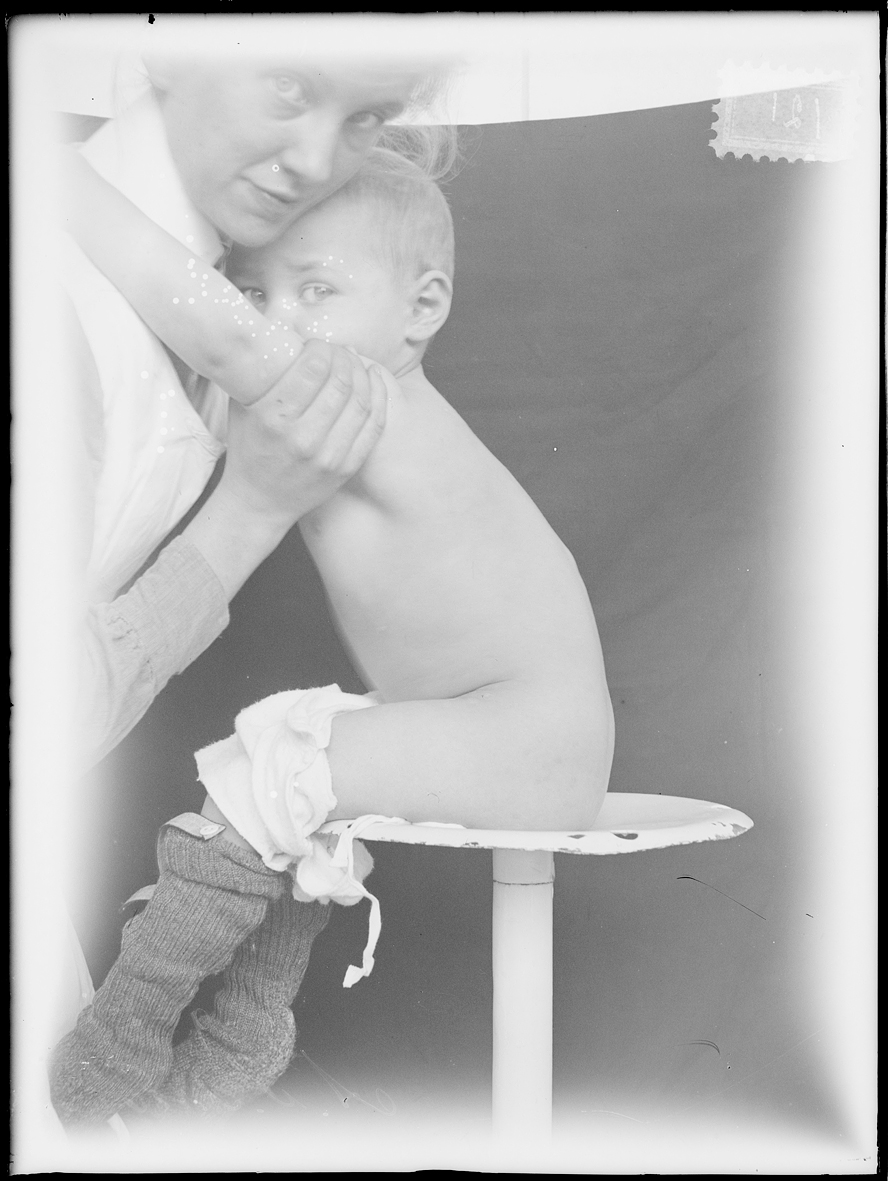 |
Fig. 11. Unknown maker, 1921. Gelatin glass negative, 120 x 90 mm. Leiden, Museum Boerhaave, inv. no. P11383.[66] |
 |
Fig. 12. Unknown maker, 1922. Gelatin glass negative, 120 x 90 mm. Leiden, Museum Boerhaave, inv. no. P11262.[66] |
 |
Fig. 13. Unknown maker, 1938. Gelatin glass negative, 180 x 130 mm. Leiden, Museum Boerhaave, inv. no. P12146.[66] |
The photographs in the Zeehospitium collection fall somewhere between clinical portrait photography and confrontational social ‘awareness’ photography. They open up a hidden world of suffering, whilst simultaneously acting as typical medical portraits. The raw honesty of the diseased bodies, captured in uncomfortable positions, reveals the presence of pain in Dutch society in the early twentieth century. A far cry from the happy children featured on the popular picture postcard images of sanatoria, these photographs reveal children suffering from a disease. Yet never do they lose their force as portraits. Produced as ‘objective’ documents of tuberculosis, these direct portraits reveal a social awareness of poverty, as well as the hardships, pain and pride of young tubercular patients, in an important era of Dutch photography and social medicine.
CV
Mieneke te Hennepe is medical historian and curator of the medical collections at the Boerhaave Museum (National Museum for the History of Science and Medicine in Leiden, the Netherlands). Her PhD thesis ‘Depicting Skin: Visual Culture in Nineteenth-Century Medicine’ was awarded with a Research Prize of the Praemium Erasmianum Foundation in 2008. She is specialized in nineteenth-century material culture of medicine, visual representation and body history. She teaches part-time at Leiden University and is council member of the European Association of Museums of the History of Medical Sciences (EAMHMS).↑
Notes
1. The author would like to thank Mara Scheelings, the volunteers at the Katwijk Museum archive, Liesbeth van Dorp, the editorial board of Depth of Field, and the anonymous peer reviewers for their comments and input.↑
2. Tagg 1988; Hamilton and Hargreaves 2001; Jordanova 2000.↑
3. See Sekula 1989.↑
4. On the early uses of photographs in science and medicine, see for example: Gilman 1976; Fox and Lawrence 1988; Maehle 1993; Thomas (ed.) 1997; Dermer, (ed.) 1999; Sheehan 2011.↑
5. Sekula 1989. For a discussion of medical photography in a cultural and art historical perspective, see: Didi-Huberman 2003; Fox and Terry 1978; Kemp 1997. On medical photography in the nineteenth century, see for example: Gernsheim 1961; Taureck 1980. ↑
6. See Biernoff 2012, p. 197.↑
7. Barnes 1999.↑
8. See for example: Bynum 2012.↑
9. Exceptions are: Connolly 2008; Bakker 2013. See also the recent oral history project in the United Kingdom: Shaw and Reeves 2009, http://www.ucl.ac.uk/histmed/downloads/the_children_of_craig_y_nos.pdf [Accessed on 20 January 2014]. ↑
10. See for example: M. Campbell 2005.↑
11. For the museum’s website, see: http://www.museumboerhaave.nl.↑
12. For the digitization, a sample was selected from the years 1908 to 1940. Also included in the acquisition are 18 gelatin silver prints (90 x 120 mm). For online access to the digitized part of the collection, see: http://www.museumboerhaave.nl/collectie/zoeken/?search=zeehospitium. ↑
13. A large portion of the glass negatives as well include X-ray images (forty-eight of the digitized negatives). These shots vary in size, between 130 x 180 mm and 180 x 240 mm. They display knees, spinal cords, hips, skulls, and other afflicted bones in tubercular children. In this article, I will focus specifically on the clinical photographs and discuss the X-rays only when befitting the context of the clinical photographs.↑
14. As a sample year, 1922 has been disclosed completely and thus provides the most complete record of images for a single year. ↑
15. See also Dekkers and Teunissen 2008.↑
16. See Hueting and Dessing 1993; De Knecht-Van Eekelen 1996.↑
17. Jaarverslag van het Rotterdamsch Zeehospitium te Katwijk aan Zee 1922, p. 15: “vermeerderen van de gezondheid, de arbeidskracht, het geluk van vele kinderen van ons volk.”↑
18. “…beroemde sanatorium te Katwijk aan Zee, dat de vergelijking met andere, oudere inrichtingen in het buitenland glansrijk kan doorstaan”: Pigeaud 1917, p. 129.↑
19. Bakker 2013, p. 10.↑
20. Pigeaud 1917.↑
21. “Het voornaamste therapeutische middel blijft de zeelucht, de frissche zeewind, zeebaden en niet het minst de zon.” Jaarverslag van het Rotterdamsch Zeehospitium te Katwijk aan Zee 1910, p. 11.↑
22. The death toll among children decreased in the Netherlands from 147 per 100.000 inhabitants in 1920 to 14 per 100.000 in 1940. See Bakker p. 10.↑
23. See for example the classic study by George Rosen (1993). For the British and American contexts, see Hamlin 1998 and Duffy 1990.↑
24. For the Dutch case, see Houwaart 1991.↑
25. Jaarverslag van het Rotterdamsch Zeehospitium te Katwijk aan Zee 1908, p. 4.↑
26. Brusse 1908. Telling is also the appearance of a Dutch journal on poor relief, the Journal of Poor Relief (Tijdschrift voor Armenzorg), first printed in 1900. The Dutch Society for Poor Relief (Nederlandse Vereniging voor Armenzorg en Weldadigheid) was founded in 1908.↑
27. Brusse 1908, 5: “meêlij van de groote, sterke menschen”.↑
28. A portion of this paragraph was previously published in an earlier version, see chapter 5 of Te Hennepe 2007.↑
29. See for example: Van Dorp-Beucker Andreae 1910, Van Dorp-Beucker Andreae 1914; Van Dorp-Beucker Andreae and Brero 1924; Van Dorp-Beucker Andreae 1936.↑
30. Leidsch Dagblad 4 November 1926; Leidsch Dagblad 28 September 1928; Nieuwe Leidsche Courant, 22 October 1932.↑
31. Interview by the author with the great-granddaughter Lisette van Dorp, January 2014. The family possessions and correspondence are kept in the family archive. See also the photographic portraits of Dieuwke Beucker Andreae as a child, taken in 1883 by the photographer Adolphe Zimmermans in The Hague (The Hague, RKD Collection Iconografisch Bureau, inv. no. IB 1022615). See also several carte-de-visite portraits by the Hague photographer Richard Kameke (The Hague, RKD Collection Iconografisch Bureau, inv. no. IB 1022616, 1883-1898), who also made portraits of a young Princess Wilhelmina van Oranje-Nassau.↑
32. Van Dorp-Beucker Andreae 1914. Glass negative with object number P11289 and figure 7 in the article are identical images. In another article, she used X-ray images similar to those preserved in the Zeehospitium collection. In all likelihood, the images used for the two articles are found in the part of the collection that still awaits digitization.↑
33. Van Dorp-Beucker Andreae 1914, p. 316.↑
34. Krauss 1978.↑
35. Burns 1979.↑
36. Gilman 1976.↑
37. On the origins of psychiatric photography, see Gilman 1982.↑
38. See Pearl 2009.↑
39. See for example: Jaarverslag van het Rotterdamsch Zeehospitium te Katwijk aan Zee 1924, p. 10.↑
40. For an overview of photographs used in medical works, see for example: Burns 1981.↑
41. See Maehle 1993, p. 565.↑
42. O’Connor 1999.↑
43. Even the X-rays in the digitized portion of the collection concern bones of the extremities, not only the lungs. The group with non-pulmonary types of tuberculosis concerned on average half of the total number of patients per year. See for example: Jaarverslag van het Rotterdamsch Zeehospitium te Katwijk aan Zee 1918.↑
44. Hamilton 2001, p. 115.↑
46. Hamilton and Hargreaves, pp. 84-107.↑
47. Hamilton and Hargreaves, p. 115.↑
48. Londe 1893. On Londe’s photographic practice, see Didi-Huberman 2003.↑
49. Londe 1893, p. x.↑
50. Ibid., p. 15.↑
51. Ibid..↑
52. Londe 1893, p. 47.↑
53. Van Dorp-Beucker Andreae 1917a; Van Dorp-Beucker Andreae 1917b. ↑
54. In the first decade of the twentieth century, in the Netherlands a debate concerning the causes of tuberculosis arose, with on the one side those who focused on improving the social conditions and on the other side those who believed in contagion. See Van Daal and De Knecht-Van Eekelen 1992.↑
55. Van Dorp-Beucker Andreae 1927, p. 7.↑
56. Pigeaud 1917.↑
57. Bakker 2013, p. 2.↑
58. Pharmaceutisch Weekblad 1914, Vol. 51, p. 261.↑
59. Algemeen Handelsblad, 30 May 1913, p. 6. Contacts with feminist organizations may very well have been initiated by Van Dorp-Beucker Andreae’s sister-in-law, Lizzie van Dorp (Elisabeth Carolina van Dorp, 1872-1945). She was a feminist, lawyer, politician, and the first female economist in the Netherlands.↑
60. Rose 1994; Strange 1989; Hine and Guibourgé 2002; Buckland 1974. See Altena 2003 on the early Dutch photography of female workers.↑
61. Brusse 1908, for example p. 46; Raemaekers 1927. ↑
62. Jaarverslag van het Rotterdamsch Zeehospitium te Katwijk aan Zee 1912, p. 4: “De verzorging van het kind dat in blakenden welstand uit het Zeehospitium, uit de omgeving van helder zonlicht, zuivere zeelucht, ruime voeding, frissche huisvesting, terugkeert naar het smalle straatje met de één of twee kamerwoning, dat zijn ouderlijk huis is, waar al die gunstige factoren ontbreken, laat nog steeds veel te wensen over. Ook daarvoor zal in de toekomst groot kapitaal noodig zijn om tegemoet te komen aan de hygiënische eischen waaraan de verzorging van het herstelde kind moet voldoen, om het tot een gezond, krachtig individu te doen opgroeien.” ↑
63. Brusse 1908, p. 5: “Voor de kleine burgertjes (…) die nu óók nog, omdat ze zich niet sterk kunnen eten en geen fiksche kleur op hun wangen stoeien en slapen in de dompe buurtjes-lucht- weerloos staan tegen den boozen vijand van arme tobbers vooral: de Tuberculose.” ↑
64. See for example the personal story of Mrs Janna Busse (1915), who explains how she remembers that some girls were always crying because of their pain or because they felt homesick: Dekkers and Teunissen 2008, p. 23.↑
65. Cf. Higonnet 1998.↑
66. Patient names on the glass negatives have been blurred and deleted from the captions due to privacy protection.↑
References
M. Altena 2003, Visuele strategieën: foto’s en films van fabrieksarbeidsters in Nederland (1890-1919), Amsterdam.
N. Bakker 2013, ‘‘Gezonde buitenlucht’ en ‘krachtige voeding’: kinderen en de anti-tuberculosecampagne in Nederland (ca. 1910–1940)’, Studium 6, No. 1, pp. 1–18.
D.S. Barnes 1999, The Making of a Social Disease: Tuberculosis in nineteenth-century France, Berkeley/Los Angeles.
M.J. Brusse 1908, Het gulden boek voor de tuberculeuse kinderen, Rotterdam.
G. Buckland 1974, Reality Recorded: Early documentary photography, Newton Abbot.
S.B. Burns 1979, ‘Early medical photography in America (1839-1883). III. The daguerrean era’, New York State Journal of Medicine 79, No. 8, pp. 1256-68.
S.B. Burns 1981, ‘Early medical photography in America (1839-1883). VII. American medical publications with photographs’, New York State Journal of Medicine 81, No. 8, pp. 1226-64.
H. Bynum 2012, Spitting Blood: The history of tuberculosis, Oxford.
M. Campbell 2005, ‘What Tuberculosis did for Modernism: The influence of a curative environment on modernist design and architecture’, Medical History 49, No. 4, pp. 463–88.
C.A. Connolly 2008, Saving Sickly Children: The tuberculosis preventorium in American life, 1909–1970 (Critical Issues in Health and Medicine), New Brunswick.
M. van Daal and A. de Knecht-Van Eekelen 1992, ‘Over aetiologie en therapie van tuberculose: Het debat in Nederland (1900-1910)’, Gewina 15, pp. 211-33.
T. Dekkers and I. Teunissen 2008, Zorg aan Zee: 100 jaar zeehospitium Katwijk 1908-2008, Leiden.
R.A. Dermer (ed.) 1999, Medicine and photography [Special issue]. History of Photography 23, No. 3.
G. Didi-Huberman 2003, Invention of Hysteria: Charcot and the photographic iconography of the Salpêtrière (A. Hartz, Trans.), Cambridge MA.
D. van Dorp-Beucker Andreae 1910, ‘Behandeling van spondylitis met het corset van Calot’, Ned Tijdschr Geneeskd. 54, pp. 1220-8.
D. van Dorp-Beucker Andreae 1914, ‘Zonbehandeling van chirurgische tuberculose aan zee’, Ned Tijdschr Geneeskd. 58, pp. 309-18.
D. van Dorp-Beucker Andreae 1917a, ‘Alcohol en tuberculose’, Ned Tijdschr Geneeskd. 61, pp. 653-5.
D. van Dorp-Beucker Andreae 1917b, ‘Alcohol en tuberculose’, Ned Tijdschr Geneeskd. 61, pp. 462-7.
D. van Dorp-Beucker Andreae and F.S.L. van Brero 1924, ‘Enkele opmerkingen over inspuiting van abscessen en fistels met levertraan’, Ned Tijdschr Geneeskd. 68, pp. 511-5.
D. van Dorp-Beucker-Andreae 1927, ‘De alcohol en het kind’, in: G.A. van Rijnberk, De Mensch en de Alcohol: Het inzicht van wetenschap en gezond verstand in het alcoholvraagstuk, Amsterdam.
D. van Dorp-Beucker Andreae 1936, ‘Eenige opmerkingen over blokvorming bij tuberculeuse spondylitis’, Ned Tijdschr Geneeskd. 80, pp. 4510-5.
J. Duffy 1990, The Sanitarians: A History of American Public Health, Urbana IL.
D.M. Fox and C. Lawrence 1988, Photographing Medicine: Images and power in Britain and America since 1840, New York.
D.M. Fox and J. Terry 1978, ‘Photography and the self image of American physicians, 1880-1920’, Bulletin of the History of Medicine 52, pp. 435-57.
A. Gernsheim 1961, ‘Medical photography in the nineteenth century, Part I.’, Medical and Biological Illustration 11, pp. 85-92.
S.L. Gilman (ed.) 1976, The Face of Madness: Hugh W. Diamond and the origin of psychiatric photography, New York.
S.L. Gilman 1982, Seeing the Insane: A cultural history of madness and art in the western world, showing how the portrayal of stereotypes has both reflected and shaped the perception and treatment of the mentally disturbed, New York.
S. Guibourgé 2002, Lewis Hine: All Work and no Play: Photographies du National Child labor Committee (1908-1918), Paris.
P. Hamilton and R. Hargreaves 2001, The Beautiful and the Damned: The creation of identity in nineteenth-century photography, Aldershot.
Ch. Hamlin 1998, Public Health and Social Justice in the Age of Chadwick: Britain, 1800–1854, Cambridge.
M. te Hennepe 2007, Depicting Skin: Visual culture in nineteenth-century medicine, unpublished PhD thesis, Maastricht University.
A. Higonnet 1998, Pictures of Innocence: The history and crisis of ideal childhood, London.
E.S. Houwaart 1991, De hygiënisten. Artsen, staat en volksgezondheid in Nederland 1840-1890, Groningen.
E. Hueting and A. Dessing 1993, Tuberculose: Negentig jaar tuberculosebestrijding in Nederland, Zutphen.
L. Jordanova 2000, Defining Features: Scientific and medical portraits 1660-2000, London.
M. Kemp 1997, ‘”A perfect and faithful record”: mind and body in medical photography before 1900’, in: A. Thomas (ed.), Beauty of Another Order: Photography in science, New Haven, pp. 120-49.
A. de Knecht-Van Eekelen 1996, ‘Geschiedenis van het genezen; de behandeling van tuberculose in Nederland rond 1900’, Ned Tijdschr Geneeskd. 140, No. 44, pp. 2195-99.
R.H. Krauss 1978, ‘Photographs as early scientific book illustrations’, History of Photography 2, No. 4, pp. 291-314.
A. Londe 1893, La photographie médicale: application aux sciences médicales et physiologiques, Paris.
A.H. Maehle 1993, ‘The search for objective communication: Medical photography in the nineteenth century’, in: R. G. Mazzolini (ed.), Non-verbal Communication in Science prior to 1900, Firenze, pp. 563-86.
E. O’Connor 1999, ‘Camera Medica. Towards a morbid history of photography’, History of Photography 23, No. 3, pp. 232-44.
S. Pearl 2009, ‘Through the Mediated Mirror: The Photographic Physiognomy of Dr Hugh Welch Diamond’, History of Photography 33, No. 3, pp. 288-305.
J.J. Pigeaud 1917, ‘Tuberculosebestrijding in de jeugd’, De Gids 81, pp. 110-31.
L. Raemaekers 1927, Gezondheid is de grootste schat, Nederlandsche Centrale Vereeniging tot Bestrijding der Tuberculose, The Hague.
J. Rose 1994, ‘Atget’s populism’, History of Photography 18, No. 1, pp. 50-63.
G. Rosen 1993, A History of Public Health [Expanded edition], Baltimore MD.
A. Sekula 1989, ‛The body and the archive’, in: R. Bolton (ed.), The Contest of Meaning: Critical histories of photography, Cambridge MA, pp. 343-88.
A. Shaw and C. Reeves 2009, The Children of Craig-y-nos: Life in a Welsh tuberculosis sanatorium 1922-1959, London.
T. Sheehan 2011, Doctored: The medicine of photography in nineteenth-century America, Pennsylvania.
M. Strange 1989, Symbols of Ideal Life: Social documentary photography in America 1890-1950, Cambridge.
J. Tagg 1988, The Burden of Representation: Essays on photographies and histories, Houndmills.
R. Taureck 1980, Die Bedeutung der Photographie für die medizinische Abbildung im 19. Jahrh, Cologne.
A. Thomas (ed.) 1997, Beauty of Another Order: Photography in science, New Haven/London.
H. Visser 1985, ‘Emmy Andriesse’, Fotolexicon 2, No. 2. Also available online: http://journal.depthoffield.eu/vol02/nr02/f01nl/en [Accessed on 28 April 2015]

